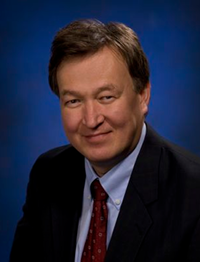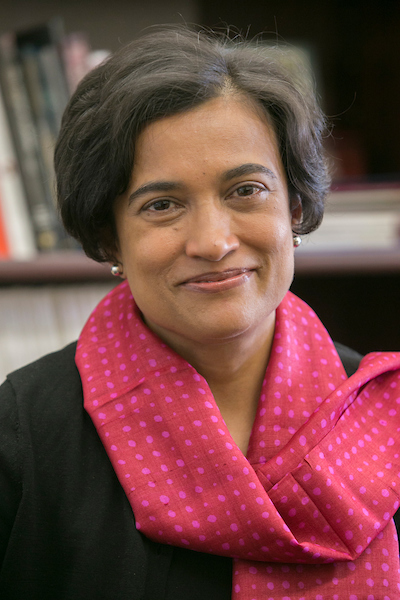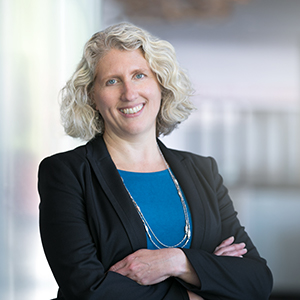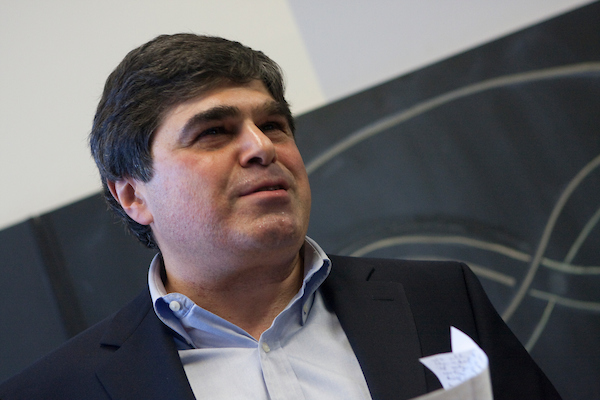Six College of Arts and Sciences Faculty Appointed to SUNY Distinguished Ranks
The State University of New York Board of Trustees recently selected six College of Arts and Sciences factulty members for the University’s highest honor — the rank of Distinguished Professor. Receiving this rank are Jessica Gurevitch, Department of Ecology and Evolution; Dmitri E. Kharzeev, Department of Physics and Astronomy; Suparna Rajaram, Department of Psychology; Nicole S. Sampson, Department of Chemistry; and Leon A. Takhtajan, Department of Mathematics.
Professor Jessica Gurevitch, a member of the Department of Ecology and Evolution, is a nationally and internationally
lauded ecologist. She was elected as a Named Fellow of the Ecological Society of America
in the inaugural year of this award, demonstrating her standing in the field. She
is also a Fellow of the American Association for the Advancement of Science. Dr. Gurevitch
is a leader in research synthesis and meta-analysis, biological invasions, and plant
ecology. She introduced contemporary quantitative research synthesis and meta-analysis
to the fields of ecology and evolution, changing the way scientists in these fields
conceptualize and review scientific data. Her work has had an impact on numerous other
fields, including human medicine and sociology. Her bestselling co-edited book, The Design and Analysis of Ecological Experiments, now in its second edition, has influenced a generation of young ecologists. She
is the lead author of a major undergraduate textbook, The Ecology of Plants, and co-authored the influential Handbook of Meta-analysis in Ecology and Evolution. Dr. Gurevitch served as an NSF Program Director, Secretary of The American Society
of Naturalists, and Executive Vice President of the Society for the Study of Evolution.
She currently serves on the Governing Board of the Ecological Society of America.
 Professor Dmitri E. Kharzeev, a member of the Department of Physics and Astronomy, is nationally and internationally
recognized as one of the world’s leading theorists in nuclear physics. He is best
known for his groundbreaking work on the Chiral Magnetic Effect (CME), which relies
on the separation of right- and left-“handed” particles in the presence of strong
magnetic fields. CME was first discovered experimentally in heavy ion collisions at
Brookhaven National Laboratory. Though the theory behind CME was initially developed
in the context of nuclear physics, it has far-reaching implications for condensed
matter physics as well. Based on Dr. Kharzeev’s prediction, he and a team of condensed
matter scientists discovered a new way to generate very low-resistance electric current
in a new class of materials. This discovery points to a range of potential applications
in energy, quantum computing, and medical imaging, and possibly even a new mechanism
for inducing superconductivity — the ability of some materials to carry current with
no energy loss. Dr. Kharzeev is an author of nearly 200 scientific publications.
Professor Dmitri E. Kharzeev, a member of the Department of Physics and Astronomy, is nationally and internationally
recognized as one of the world’s leading theorists in nuclear physics. He is best
known for his groundbreaking work on the Chiral Magnetic Effect (CME), which relies
on the separation of right- and left-“handed” particles in the presence of strong
magnetic fields. CME was first discovered experimentally in heavy ion collisions at
Brookhaven National Laboratory. Though the theory behind CME was initially developed
in the context of nuclear physics, it has far-reaching implications for condensed
matter physics as well. Based on Dr. Kharzeev’s prediction, he and a team of condensed
matter scientists discovered a new way to generate very low-resistance electric current
in a new class of materials. This discovery points to a range of potential applications
in energy, quantum computing, and medical imaging, and possibly even a new mechanism
for inducing superconductivity — the ability of some materials to carry current with
no energy loss. Dr. Kharzeev is an author of nearly 200 scientific publications.
 Professor Suparna Rajaram, a member of the Department of Psychology, is a leading scholar in the experimental
study of human memory. Her early work on explicit versus implicit memory and recollective
experience has influenced major theories of memory. Dr. Rajaram pioneered a conceptual
framework to study cognitive mechanisms that underpin memory transmission in groups
and the emergence of collective memory. Her major contributions include the introduction
of novel paradigms to model social networks in the laboratory. Dr. Rajaram’s research
has appeared in top journals and has received support from the National Institute
of Mental Health, the Russell Sage Foundation, the National Science Foundation (NSF),
Google and others. She is the recipient of the prestigious FIRST Award from the National
Institute of Mental Health. Dr. Rajaram was President (2017-18) of the Association
for Psychological Science and Chair of the Psychonomic Society Governing Board. A
Fellow of AAAS and the Society of Experimental Psychologists, and associate editor
of three major journals, Dr. Rajaram was a featured memory scholar in the Rubin Museum
of Art’s Brainwave Series. She also co-founded an international group, Women in Cognitive
Science, supported by NSF to promote gender equity in cognitive sciences.
Professor Suparna Rajaram, a member of the Department of Psychology, is a leading scholar in the experimental
study of human memory. Her early work on explicit versus implicit memory and recollective
experience has influenced major theories of memory. Dr. Rajaram pioneered a conceptual
framework to study cognitive mechanisms that underpin memory transmission in groups
and the emergence of collective memory. Her major contributions include the introduction
of novel paradigms to model social networks in the laboratory. Dr. Rajaram’s research
has appeared in top journals and has received support from the National Institute
of Mental Health, the Russell Sage Foundation, the National Science Foundation (NSF),
Google and others. She is the recipient of the prestigious FIRST Award from the National
Institute of Mental Health. Dr. Rajaram was President (2017-18) of the Association
for Psychological Science and Chair of the Psychonomic Society Governing Board. A
Fellow of AAAS and the Society of Experimental Psychologists, and associate editor
of three major journals, Dr. Rajaram was a featured memory scholar in the Rubin Museum
of Art’s Brainwave Series. She also co-founded an international group, Women in Cognitive
Science, supported by NSF to promote gender equity in cognitive sciences.
 Professor Nicole S. Sampson, interim Dean of the College of Arts and Sciences and faculty member in the Department
of Chemistry, is an internationally known scholar in chemical biology and organic
chemistry. Her research contributions include enzymology of bacterial cholesterol
metabolism, drug and diagnostic discovery for treatment of tuberculosis, pioneering
the use of polymer probes to unravel mammalian sperm-egg interactions, and developing
precisely alternating copolymer synthetic methodology. Professor Sampson has received
$16 million in research support from Federal and private agencies. She has written
more than 100 research papers and reviews in high profile journals and holds five
issued patents. Dr. Sampson’s honors and awards include the Camille and Henry Dreyfus
New Faculty Award, an NSF CAREER Award, the Arthur C. Cope Scholar Award, and the
Pfizer Award in Enzyme Chemistry, both from the American Chemical Society (ACS), the
Research Foundation of SUNY Research and Scholarship Award, and the New York State
NYSTAR Faculty Development Award. She has served in leadership positions in the ACS,
and provided major service to the NIH and NSF. Dr. Sampson currently co-directs an
NIH- funded Chemical Biology Graduate Training Program and served as Chair of the
Chemistry Department from 2012-2017.
Professor Nicole S. Sampson, interim Dean of the College of Arts and Sciences and faculty member in the Department
of Chemistry, is an internationally known scholar in chemical biology and organic
chemistry. Her research contributions include enzymology of bacterial cholesterol
metabolism, drug and diagnostic discovery for treatment of tuberculosis, pioneering
the use of polymer probes to unravel mammalian sperm-egg interactions, and developing
precisely alternating copolymer synthetic methodology. Professor Sampson has received
$16 million in research support from Federal and private agencies. She has written
more than 100 research papers and reviews in high profile journals and holds five
issued patents. Dr. Sampson’s honors and awards include the Camille and Henry Dreyfus
New Faculty Award, an NSF CAREER Award, the Arthur C. Cope Scholar Award, and the
Pfizer Award in Enzyme Chemistry, both from the American Chemical Society (ACS), the
Research Foundation of SUNY Research and Scholarship Award, and the New York State
NYSTAR Faculty Development Award. She has served in leadership positions in the ACS,
and provided major service to the NIH and NSF. Dr. Sampson currently co-directs an
NIH- funded Chemical Biology Graduate Training Program and served as Chair of the
Chemistry Department from 2012-2017.
 Professor Leon A. Takhtajan, a member of the Department of Mathematics, is a highly regarded mathematical physicist
who has produced fundamental and pioneering work on the theory of classical and quantum
integrable systems and string theory, with deep applications to algebraic geometry,
the Teichmüller theory of Riemann surfaces, and number theory. He has co-authored
several highly influential textbooks, regarded as must-reads for several generations
of mathematical physicists. Dr. Takhtajan has played a crucial role in shaping his
department over the past three decades, including serving as department Chair for
four years. He also played an instrumental role in founding the Simons Center for
Geometry and Physics. Dr. Takhtajan’s outstanding achievements have been recognized
by an invitation to give an address to the International Congress of Mathematicians
and a plenary address to the annual meeting of the American Math Society. He received
a Clay Math Institute Fellowship and was elected to the inaugural class of Fellows
of the American Mathematical Society.
Professor Leon A. Takhtajan, a member of the Department of Mathematics, is a highly regarded mathematical physicist
who has produced fundamental and pioneering work on the theory of classical and quantum
integrable systems and string theory, with deep applications to algebraic geometry,
the Teichmüller theory of Riemann surfaces, and number theory. He has co-authored
several highly influential textbooks, regarded as must-reads for several generations
of mathematical physicists. Dr. Takhtajan has played a crucial role in shaping his
department over the past three decades, including serving as department Chair for
four years. He also played an instrumental role in founding the Simons Center for
Geometry and Physics. Dr. Takhtajan’s outstanding achievements have been recognized
by an invitation to give an address to the International Congress of Mathematicians
and a plenary address to the annual meeting of the American Math Society. He received
a Clay Math Institute Fellowship and was elected to the inaugural class of Fellows
of the American Mathematical Society.
Professor Mary F. Kritzer, Department of Neurobiology and Behavior and also a a member
of the School of Medicine , was named Distinguished Service Professor. Professor Kritzer has provided outstanding service to the University in many capacities beyond her primary
teaching and research responsibilities. She has volunteered to serve on medical school
governance, the University’s athletics programs, services for underrepresented graduate
students, and services for commuter students. She has also gained an impressive reputation
for service outside the University by participating in science programs in local high
schools, serving as an effective leader in numerous NIH study section activities,
and bringing the Healthy Minds Across America Outreach program to Stony Brook University. Dr. Kritzer has twice taken on the demanding task
of graduate program director for her home department, a crucial aspect of the departmental
mission. Individuals inside and outside the University write glowingly of her willingness
to serve in multiple capacities and the reliability of her service as a go-to person.
Her teaching has received numerous awards, and her research program on cerebral cortex
function has been externally funded and published in high quality international journals.
The Distinguished Professorship is given to individuals who have achieved national and/or international prominence and a distinguished reputation within their chosen field. This distinction is attained through extraordinary contributions to, and impact on, the candidate’s field of study, often evidenced by significant research and/or creative activity. Moreover, the candidate should be a role model for students and other faculty and their work must be of such character that it has the potential to elevate the standards of scholarship or creative activity of colleagues both within and beyond their academic fields. Their work must be of such quality that students and scholars on other SUNY campuses would wish to benefit from lectures and seminars, or other appropriate presentations the faculty members might provide. Further, to be eligible for nomination, a faculty member must have attained and held the rank of full professor for five years, and must have at least one year of full-time service at the nominating institution.
More information about SUNY’s faculty award program is available online.
